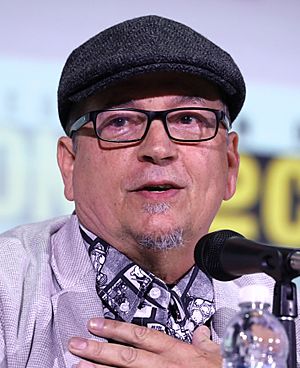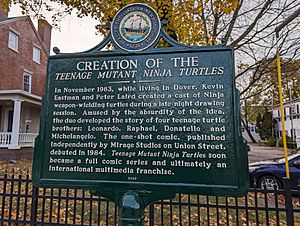Kevin Eastman facts for kids
Quick facts for kids Kevin Eastman |
|
|---|---|

Eastman in 2023
|
|
| Born | Kevin Brooks Eastman May 30, 1962 Portland, Maine, U.S. |
| Area(s) |
|
|
Notable works
|
Teenage Mutant Ninja Turtles, Heavy Metal, The Melting Pot |
|
Notable collaborations
|
Peter Laird, Eric Talbot, Simon Bisley |
| Awards | Inkpot Award (1989) |
| Spouse(s) |
Julie Strain
(m. 1995–2006)Courtney Carr
(m. 2013) |
| Children | 2 |
| Signature | |
Kevin Brooks Eastman (born May 30, 1962) is an American comic book writer and artist. He is most famous for co-creating the Teenage Mutant Ninja Turtles with his friend Peter Laird. Eastman also used to be the editor and publisher of the science-fiction and fantasy magazine Heavy Metal.
Contents
Early Life and First Comics
Kevin Eastman was born in Portland, Maine. He went to Westbrook High School, where he became friends with another future comic book artist, Steve Lavigne. As a kid, Eastman loved comic books. His hero was the famous artist Jack Kirby, and his favorite comic was Kamandi.
In 1983, Eastman worked in a restaurant while trying to get his comics published. He met a waitress and followed her to Northampton, Massachusetts. There, he met Peter Laird, who lived in a nearby town. The two started working together on different comic book ideas.
In May 1984, Eastman and Laird published the first issue of Teenage Mutant Ninja Turtles themselves. It was a black-and-white comic. They printed about 3,275 copies, using a $1,000 loan from Eastman's uncle. They called their company Mirage Studios. Eastman said it was because they didn't have a real studio, just "kitchen tables and couches." By September 1985, the first issue was so popular it had been reprinted three more times.
The Teenage Mutant Ninja Turtles Take Over
Eastman and Laird created a press kit with a story summary and artwork. They sent it to 180 TV and radio stations. This got them a lot of attention in the news, and soon everyone wanted their comic.
The second issue of the Turtles comic was a huge success. They received orders for 15,000 copies, which was five times more than the first issue's print run. This success allowed Eastman and Laird to quit their jobs and become full-time comic book creators. The Turtles became a phenomenon, and the two were invited to comic conventions where they met famous creators.
Turning Turtles into Toys and TV Shows
The success of the Turtles comic led to many other products. Merchandising became a big part of their business.
- Figurines: A company made small lead figures of the Turtles for collectors and gamers.
- Role-Playing Game: Palladium Books created a game where players could pretend to be the Turtles.
- Comic Collections: The first eleven issues were reprinted in color.
The role-playing game helped the Turtles get noticed by a licensing agent. Soon, the Turtles were on T-shirts, mugs, and Halloween masks. In December 1987, a five-part cartoon series about the Turtles appeared on TV. It was a huge hit and led to a full series that ran for 10 seasons and 193 episodes.
..... These toys became incredibly popular and made Eastman and Laird very successful.
The Turtles on the Big Screen
The Turtles have starred in many movies and TV shows over the years. This includes live-action films like Teenage Mutant Ninja Turtles (1990) and animated movies like Teenage Mutant Ninja Turtles: Mutant Mayhem (2023).
Eastman has stayed involved with the Turtles. He wrote an episode of the 2012 TV series and even had a small voice role in the Mutant Mayhem movie.
A New Chapter for the Creators
Over time, Eastman and Laird had different ideas about the future of the Turtles. In 2000, Laird and Mirage Studios bought Eastman's share of the Teenage Mutant Ninja Turtles property. This allowed Eastman to focus on new projects.
However, Eastman returned to the world of the Turtles in 2011. He started working on the new TMNT comic book series from IDW Publishing. He also worked as an advisor on the 2014 movie. In 2020, Eastman and Laird teamed up again for a special comic book project called Teenage Mutant Ninja Turtles: The Last Ronin.
Helping Other Comic Creators
Eastman wanted to help other comic book artists keep control of their own creations. He started his own publishing company, Tundra Publishing, in 1990. His goal was to give artists a place to publish their dream projects while still owning their work.
Eastman explained his idea: "Basically, I'd meet them at conventions and they'd said they're stuck doing Spider-Man... But if they really had a chance, they said they'd really do this [at Tundra]... I asked them what they'd like to do. They could pick their dream projects... and I would provide the funding."
Tundra published many important comics, including The Crow and Mike Allred's Madman. However, running the company was harder than Eastman expected. It grew very quickly and cost a lot of money to run. After three years, Tundra merged with another company, Kitchen Sink Press. Even though Tundra lost a lot of money, Eastman said he learned valuable lessons from the experience.
Publishing Heavy Metal Magazine
Eastman was a big fan of the science fiction and fantasy magazine Heavy Metal. The magazine featured art from European artists that was new to American readers. When he found out the magazine was for sale, he bought it in 1992.
Eastman wanted to use Heavy Metal to introduce comic book fans to new artists and stories. He owned the magazine for over 20 years. He sold it in 2014 but continued to work as its publisher until 2020.
Other Projects and Personal Life
Besides his work with the Turtles, Eastman has been involved in many other creative projects. He created a black-and-white graphic novel called Fistful of Blood with artist Simon Bisley. He has also appeared in a few movies and wrote an episode for the animated kids' show Corn & Peg.
Eastman is also a serious art collector. He bought his first piece of original comic art in 1984. His love for comic art led him to open the Words & Pictures Museum in 1992, which displayed comic and fantasy art for several years.
Eastman was married to model and actress Julie Strain from 1995 to 2006. On October 5, 2013, he married actress and producer Courtney Carr. He has two children.



